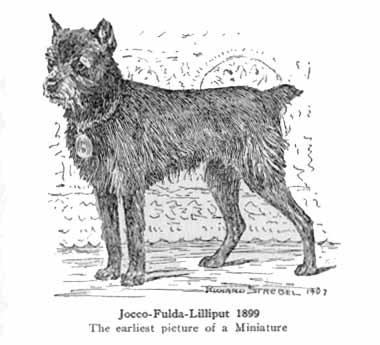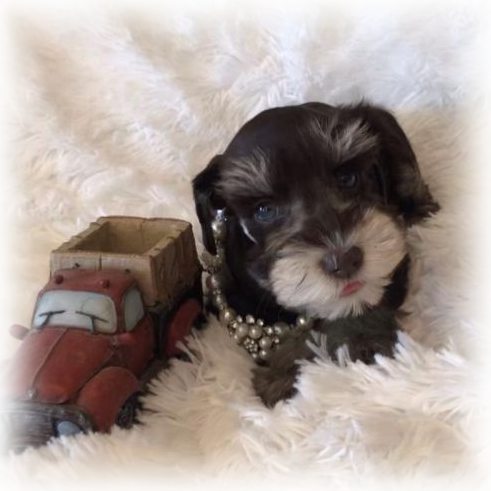About Miniature Schnauzers
History

The breed today known as the Standard Schnauzer, one of Europe’s supreme all-around farm dogs, has a lineage going back to at least the 15th century. Old-time German farmers bred the Standard down to miniature size, the better to work as fearless barnyard ratters.
With his rat-dog background, the Miniature Schnauzer resides in the AKC Terrier Group with other diminutive rat-catcher breeds. But the Mini is unique among AKC terriers in that he has no British blood in his veins. The vast majority of the terrier breeds were developed in the British Isles. The few created outside of Britain—the Rat Terrier or the Cesky Terrier, for instance—were created with crosses to existing British breeds.
Alone among terriers, the Miniature Schnauzer is wholly a product of Continental stock: Standard Schnauzer, Affenpinscher, and Poodle. This explains that though the Mini was born to the traditional work of small terriers, his personality is quite different. Not for him is the dour independence of the Scottish Terrier or the fiery temperament of the Irish Terrier. Rather, he is an overtly friendly dog, spirited but obedient and willing to please.
For the most part, the Miniature Schnauzer’s ratting days are long behind him. Today, he is best known as a charming and attractive companion, and a steady winner at dog shows here and abroad. Of the three Schnauzer breeds, the Miniature ranks consistently highest in AKC registrations.
Recognized by the AKC in 1926 as the club's 80th breed.
Temperament and Personality

Miniature schnauzers are a very charming and attractive breed, displaying unbound devotion and love to their family, and demanding the same in return! Minis tend to be very intelligent, easily trainable, and very clean. They are as at home in an apartment as they are in the country, and love to go for a walk, or just play fetch in the living room. They get plenty of exercise following you from room to room, as they never want to be without you. They can be a bit stubborn when trying to get their way, but are very clever in "teaching YOU" to do what they wish. They are not incessant barkers if raised and trained properly, but will readily announce anything or anyone that is out of place. Many schnauzers are "talkers", in that they are very vocal when greeting you; for instance when you have been away and returned home. It is not barking, but a "woo-woo, roo-roo, grunt groan" type of sheer bliss that you have finally returned to love them, even if all you did was go get the mail!!!!
Health Issues
Mini schnauzers are generally a healthy breed, and are not usually plagued by very many health problems. One of the biggest problems with minis seems to be controlling their weight. But regular exercise and proper nutrition will easily control this problem. One particular nutrition related problem that is occuring with increasing frequency in miniature schnauzers is pancreatitis. It is not clearly understood, but appears to be associated with the fact that many mini schnauzers have high blood serum lipids (fats). Symptoms generally include lack of appetite, repetitive vomiting and diarrhea, abdominal pain, lethargy and depression. It is very much an emergency situation which requires immediate veterinary care to prevent more serious illness or even death. It can be prevented by maintaining your adult mini on a lower fat diet. Another potential life-threatening problem is hyper-sensitivity to vaccines. Symptoms include facial swelling and extreme itchiness, and possible breathing problems. Vomiting and diarrhea can also occur.
Your puppy/dog should never be left alone after vaccinations are given, as any delay in treatment for allergic reactions to vaccines can be fatal. Most serious reactions have been known to occur within eight hours after injection, but be watchful up to 24 hours or so in case your dog has not read the book and reacts later than usual. Eye problems which can occur in the breed include congenital juvenile cataracts and progressive retinal atrophy, both of which cause blindness. Good breeders have their breeding stock screened by a board certified ACVO opthalmologist. Other problems which are not necessarily common, but can occur in the breed, include urolithiasis (urinary tract infections and/or bladder stones), hypothyroidism, skin/allergy problems, liver shunts, epilepsy, juvenile kidney failure, and heart defects. Even though some of these problems are more prevalent in this breed than in some other breeds, they are not all hereditary. And to make things more complicated, some of them can be either hereditary or acquired (non-hereditary). This can make things more complicated when it comes to breeding decisions, guarantees etc., but no good breeder would deliberately use a dog in their breeding program which has a known hereditary problem.
Health Update as of 2011. There has been a lot of controversy for a number of years surrounding over vaccination of puppies and dogs, and the long term seriou s health issues which that can potentially cause! Unfortunately you cannot always trust your vet to do what is right for your dog. Many vets tend to generalize and use the same vaccine protocols for every single puppy or dog in their practise, regardless of very different individual circumstances. This is just unacceptable today with the up to date knowledge that is easily accessible! You would not have to give a small breed country house dog that is never around other dogs, the same variety of vaccines and preventatives that you would give a dog that travels extensively to various provinces or goes to dog shows or dog parks where contact with innumerable bacteria, viruses, parasites etc. is much more likely. Some vaccines such as Lepto are known to cause such severe reactions that many vets refuse to use them in many parts of the world unless ABSOLUTELY necessary. Some vaccines only cover one or two strains out of hundreds, and the strains covered may not even exist in your geographical area! It pays to do some research before injecting, spraying or feeding your pet with anything that you do not have to. Please, be your own and your pet's best advocate. There is an abundance of info on the web in regards to proper vaccination protocols. The world reknowned leaders in vaccine research are Dr. W. Jean Dodds and Dr Ronald D. Schultz, whose vaccination protocol is now being adopted by ALL 27 North American veterinary schools.
Now let's talk about fleas. If your dog does not have fleas, do not use flea preventatives month after month! I have only used flea preventatives once or twice a year some years, many other years not at all. I use it ONLY as needed, not as most vets would have you do, (start as the snow melts and go every month until frost...) that is such an unnatural intrusion on my dogs' wellbeing, which has proven to be totally unnecessary in the 30 years I have been involved with dogs! Don't waste your money and don't risk your dog's health. If you see fleas, do only what is necessary to eliminate them. That does not necessarily mean you have to use flea products for 6-8 months on end. If you live somewhere that you have to and you know that, fine, but do not do it if is not needed, it all affects the immune system of your pet!
Tail Docking
The tails are docked when the puppies are three days old. Docked tails are part of the AKC standard. The tail is "set high and carried erect. It is docked only long enough to be clearly visible over the backline of the body when the dog is in proper length of coat. A properly presented Miniature Schnauzer will have a docked tail as described; all others should be severely penalized."
Ear Cropping
Cropping of ears was done originally to protect the dog from injury while working or hunting. Then as breeds began to attend dog shows it became the norm and is now part of the official breed standard for many breeds. Personally, we do not crop our dogs' ears and do not recommend having it done. There are no benefits that we can think of at this time for cropping any miniature schnauzer's ears.
